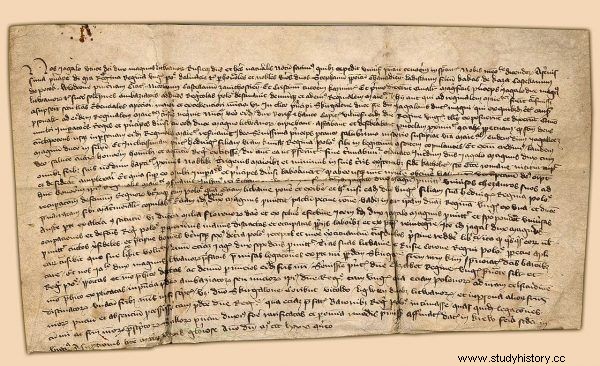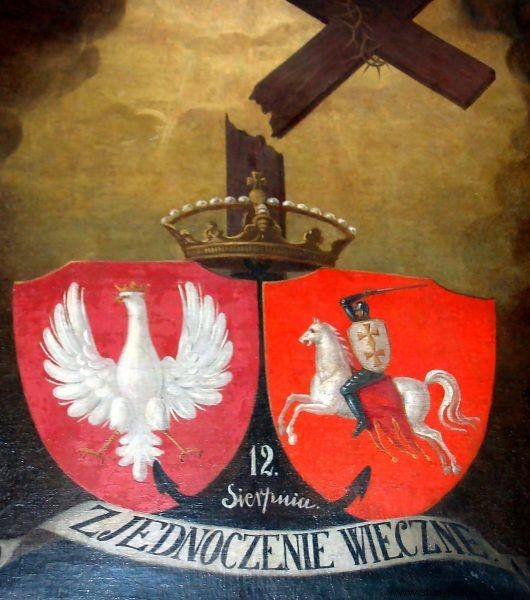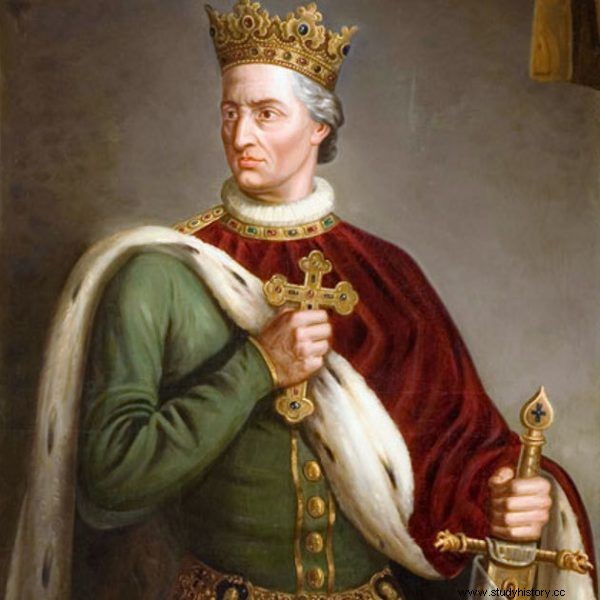Polish historians still maintain that in 1386 the Lithuanian state disappeared from the map of Europe. Lithuanians talk about forgery, great genocide and Polish lies. What really happened in Krewo in 1385? And how to understand the document underlying the Polish-Lithuanian union?
The bloody act is without a doubt one of the strangest documents in Polish history. At the core of the union between the Kingdom of Poland and the Grand Duchy of Lithuania, which survived four centuries and completely changed the image of European politics, is a short and vague piece of parchment.

Władysław Jagiełło on an unfinished sketch by Jan Matejko.
It was not even an act of union, although it is often referred to as that. In Krewo on August 14, 1385 (today's Belarus, roughly halfway between Vilnius and Minsk), only a prenuptial agreement was concluded, in which the Lithuanian prince Jogaila made a number of commitments in exchange for the consent of Polish magnates to give him the hand of the young queen Jadwiga Andegaweńska.
The document was only 26 lines long and 560 words long. No other agreement was reached, however:the entire relationship between the states was based on this concise note.
The Lithuanian Grand Duke Jogaila (known as Jagiełło in our company) undertook to pay off the claims of Jadwiga Wilhelm's fiancée, be baptized with his family, introduce Christianity throughout his country and release Polish prisoners of war in Lithuanian captivity. All these promises are not in doubt or controversy. However, the Lithuanian prince Jagiełło did something else.

The original of the Kreva act kept in the cathedral archives in Krakow.
Finally, he promised that he would "perpetually join his Lithuanian and Ruthenian lands to the Crown of the Kingdom of Poland".
Union in Krewo. A Polish view of the bloody act
This sentence caused a storm in the world of science for generations. The dispute, in fact, is not even about the entire obligation, but about a single word spoken by the Grand Duke of Lithuania. In the Latin original of the act, the verb "applicare" is not entirely clear to describe what Jagiełło was supposed to do.
Polish historians began to convince in the 19th century that the word "applicare" was a synonym for the term "incorporare". This would mean that Jagiełło agreed in Krewo not even to a union between countries, but - to the complete liquidation of the Lithuanian state and its "incorporation" into the Kingdom of Poland.
This judgment, in various forms, was repeated throughout the twentieth century and, in fact, is still considered the most popular interpretation on the Vistula River. Professor Grzegorz Błaszczyk, considered to be one of the best native experts on the subject, emphasized that "the blood act was an act of Lithuania's incorporation into Poland, which should be beyond doubt". Similar opinions were also expressed in the works of Jarosław Nikodem and Henryk Łowmiański.
Union in Krewo. Lithuanian view on the bloody act
Understandably, the Lithuanians view the issue in a completely different way. Thanks to the blood act, Jagiełło gained the reputation of a traitor who sold the state to the Polish people. From the beginning of the 20th century, such a picture was created and distributed by nationalists, and from the interwar years it became, in fact, the binding interpretation of history.
The Soviet authorities also eagerly picked up criticism of Krewo and the entire Polish-Lithuanian union. In turn, in exile, in Chicago, even a work was published proving that Jagiełło initiated the great genocide of Lithuanians in 1385 ...
Lithuanian scientists are more moderate in their opinion, but they also completely diverge from their Polish colleagues in the courts. The dominant view among historians from over the Neris is that "applicare" did not mean "connection", but at most - "connection". So no incorporation took place, and even its promise should be placed under a big question mark.

19th-century painting commemorating the Polish-Lithuanian union
In Lithuanian textbooks, such as the History of Lithuania translated into Polish a few years ago. From the earliest times to 1795 - there are even repeated (long rejected by specialists) assumptions that the act of union in Krewo is a fake or insignificant rough draft, followed by a true but lost act of union of Poland and Lithuania.
Union in Krewo. A view from the outside
There is no need to count on a quick solution to the "applicare" puzzle. However, it is worth looking at the subject coolly, from a distance, without being burdened with national resentments. This is what Robert Frost is doing - a British historian who knows both Polish and Lithuanian well. He is the author of the work just published on the Vistula River "Oxford history of the Polish-Lithuanian union. The rise and development of 1385-1569 ” (Rebis 2018).
In the pages of his book, Frost emphasizes that the blood act contained promises, not political decisions, and that is also how the mention of "joining" Lithuania should be treated:
Although some of the promises made in Kreva (...) were fulfilled almost immediately - Jogaila, his pagan brothers and Witold were baptized as promised, the baptism of all Lithuania soon began, Jogaila, on the other hand, married Jadwiga and was crowned - the others were not met or they later lost their importance, such as the issue of compensation for Wilhelm Habsburg, which he did not accept.

Władysław Jagiełło in the painting by Michał Godlewski.
Thus, even if applicare really meant "to incorporate" - and [Henryk] Łowmiański, citing numerous documents from that time, shows that this term was then used both in private and public law - this remained in the sphere of promises.
No incorporation documents have survived, and no other sources contain any indication that the incorporation formally took place in 1386.
Author of "Oxford History of the Polish-Lithuanian Union" he does not think, however, as some historians do, that the word "applicare" was used accidentally in the act or that its meaning was not overly emphasized.
The British historian suggests that this term could be convenient for both Jagiełło and Polish gentlemen. In his opinion, it can be assumed - on the basis of the wording in the document - that the contracting parties did not mean to include Lithuania into the Polish kingdom, but to the broadly understood "crown of the kingdom" - that is, to the full catalog of lands and titles under the authority of the kings sitting in Krakow.
Such inclusion was supposed to suggest that both Lithuanians and Poles want a permanent arrangement going beyond the ad hoc personal union. So about a relationship that was actually made and that survived until the end of the modern era.
